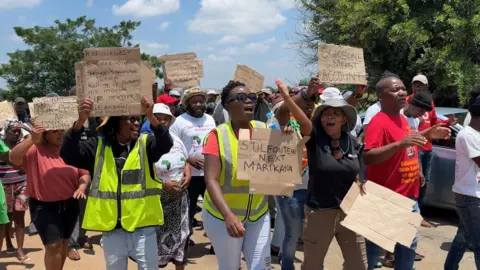The grim toll from the Stilfontein mine disaster continues to climb. Thirty-six more bodies were recovered on Tuesday, bringing the confirmed death toll to a staggering 51, according to National police spokesperson, Brigadier Athlenda Mathe.

The rescue operation, which resumed on Monday after a weekend of clearing the site and deploying a heavy-duty crane, is expected to continue for another 10 to 16 days. On Monday alone, 35 miners were extracted, with nine declared dead upon reaching the surface.
A joint statement from the Department of Police and the Department of Mineral Resources and Energy detailed the post-extraction process: “Once they are extracted, the illegal miners are inspected for any illicit items such as gold nuggets and illegal firearms and thereafter assessed by paramedics on site. Those that require further medical care are taken to a health facility for further medical care, while those who are in good health are immediately detained.”

All rescued miners undergo nationality and immigration status checks before being held in police cells.

President of the General Industries Workers Union of South Africa (GIWUSA), Mametlwe Sebei, didn't mince words, referring to the incident as the "Stilfontein massacre".
He stated, “What has transpired here has to be called what it is. This is Stilfontein massacre, because what the footage does is that it shows a pile of human bodies, of miners that died needlessly. This massacre, which is what it is, is really a bloody culmination of a treacherous policy that was pursued by the government, and in this police operation.”

Sebei estimates that as many as 109 bodies remain trapped within the mine shaft.
The images emerging from the mine are harrowing. Photos show emaciated men being carried out on stretchers, while others sit surrounded by police and paramedics. The miners were engaged in illegal mining activities within an abandoned gold mine, a situation that escalated into a prolonged standoff with authorities.
In an attempt to force their surrender, police cut off the miners' access to food, water, and other essential supplies – a tactic described as an attempt to "smoke them out". The rescue operation employs a cage-like structure to lift the men from a depth of over 2km.
However, the authorities' claim that surviving miners are refusing to emerge has been strongly disputed by rights groups and activists. They argue that the only escape route involves a perilous journey to another shaft, a trek that can take days and requires navigating treacherous conditions.

This tense standoff between police, miners, and the local community began in November when authorities initiated the operation to remove the illegal miners. At the time, Cabinet minister Khumbudzo Ntshavheni made it clear that the government would not assist the miners, stating, "We are not sending help to criminals. We are going to smoke them out. They will come out." This approach has been heavily criticised in the wake of the rising death toll.
Illegal mining is a persistent problem in South Africa's gold-rich regions, particularly in abandoned mines no longer deemed profitable by mining companies. These abandoned shafts become attractive targets for informal miners seeking to extract remaining gold deposits. Police maintain that those still trapped are attempting to evade arrest, while activists and relatives contend that the miners are physically incapable of exiting the mine due to the perilous conditions and lack of supplies.
The legal proceedings surrounding the rescue operation also played a role in the delay. The high court ordered the state to finalise and send a service-level agreement and a letter of appointment to Mines Rescue Services before the rescue could commence. This legal process contributed to the time elapsed before the rescue operation began in earnest.
The human cost of this tragedy is deeply felt by families affected. Tom, whose brother is still missing, expressed her frustration and anxiety: “I have mixed feelings about how this whole thing was handled. Why couldn’t they have started the rescue operation earlier? Maybe some lives could have been saved. One of the miners who was rescued [on Monday] said that he saw my brother two weeks ago but had not seen him since. As a family we are just praying that he is brought to the surface alive.”
The gravity of the situation prompted visits from Minister of Police Senzo Mchunu and Minister of Mineral and Petroleum Resources Gwede Mantashe to the site on Tuesday. Their arrival was met with protests from community members and civil society organisations demanding accountability for the government's perceived inaction. A picket was held along the road leading to the mineshaft, highlighting the community's anger and frustration.
During a press conference, the ministers briefly allowed media access closer to the site, offering a glimpse of the scene: emaciated miners being assisted into ambulances, one miner carried on a stretcher, unable to walk. The ministers' motorcade was even briefly blocked by protesters demanding that the officials address their concerns directly.

The protests were not merely expressions of anger; they were demands for justice. Zethu Hlatshwayo from the Association of Artisanal Miners voiced the sentiment shared by many, directly blaming the government and the ministers for the loss of life.
“These ministers think that they are above the law. They can’t even address people who have lost loved ones underground. We are not going to leave this situation as is; we are going to continue to demand accountability as people have been starved to death down there.”

Follow Us on Twitter










